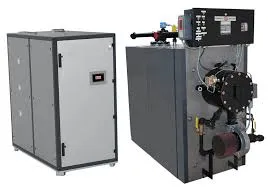ное. . 06, 2024 15:12 Back to list
Efficient Design and Performance of Compact Shell-and-Tube Heat Exchangers for Various Applications
Compact Shell and Tube Heat Exchanger A Comprehensive Overview
Heat exchangers play a vital role in various industrial processes, enabling efficient heat transfer between two or more fluids. Among the different types of heat exchangers, the compact shell and tube heat exchanger has gained prominence due to its efficiency in managing limited space while providing a high surface area for heat transfer. This article delves into the design, working principles, advantages, and applications of compact shell and tube heat exchangers.
Design and Working Principle
A compact shell and tube heat exchanger consists of a series of tubes, with one fluid flowing through the tubes and another fluid either surrounding the tubes within the shell or flowing in the opposite direction. The configuration allows for a significant surface area to facilitate heat transfer between the exiting and entering fluids. Compact heat exchangers are specifically designed to maximize heat transfer while minimizing the overall volume and weight.
The construction typically features a smaller diameter of tubes than traditional shell and tube exchangers, which leads to a compact arrangement. The use of enhanced tube geometries and materials further improves the heat transfer efficiency. These exchangers can operate under high-pressure and temperature conditions, making them suitable for various applications.
The working principle hinges on the concept of thermal conduction, where heat passes from the hot fluid to the colder fluid through the tube walls. The effectiveness of heat transfer is determined by factors such as fluid velocity, temperature difference between the fluids, and the properties of the materials used in the exchanger.
Advantages of Compact Shell and Tube Heat Exchangers
1. Space-Efficiency One of the primary advantages of compact shell and tube heat exchangers is their ability to deliver high heat transfer rates within a smaller footprint. This makes them ideal for facilities where space is a limiting factor.
2. Enhanced Heat Transfer The design and construction of these exchangers allow for improved heat transfer efficiency compared to standard shell and tube models. Enhanced surface areas, along with potential features such as finned tubes, contribute to this improvement.
compact shell and tube heat exchanger

3. Flexibility in Design Compact shell and tube heat exchangers can be designed to suit specific applications, including various tube configurations, materials, and flow arrangements. This adaptability makes it easy to customize them for individual operational requirements.
4. Robustness These exchangers are built to withstand a wide range of temperatures and pressures, making them suitable for challenging operational environments. Their structural integrity ensures reliability over long operating periods.
5. Cost-Effectiveness Despite their advanced design, compact shell and tube heat exchangers can lead to reduced operational costs due to their efficiency in energy use and minimized material requirements.
Applications
Compact shell and tube heat exchangers are prevalent in various industries, including chemical processing, petroleum refining, power generation, and HVAC systems. They are utilized for tasks such as
- Cooling and Heating In reactors or process lines, they are used to either cool or heat process fluids, contributing to optimal operational temperatures. - Condensation and Evaporation These exchangers excel in applications involving phase changes, such as condensing vapors or evaporating liquids in distillation processes.
- Waste Heat Recovery They are commonly employed in systems designed for recovering waste heat, enhancing overall energy efficiency and reducing environmental impact.
Conclusion
In summary, compact shell and tube heat exchangers represent a significant advancement in heat exchange technology, combining efficiency, adaptability, and robustness. Their ability to optimize space usage while delivering exceptional thermal performance makes them an invaluable component in modern industrial applications. As industries continue to seek energy-efficient solutions, the relevance of these compact heat exchangers is likely to grow, making them a critical area of focus for engineers and designers alike.
-
Durable Cast Steel Concrete Pipe Mold Bottom Rings & Base Trays
NewsAug.23,2025
-
Centrifugally Cast Iron Water Main Pipe for Reliable Mains
NewsAug.22,2025
-
Durable Centrifugally Cast Iron Water Main Pipe
NewsAug.11,2025
-
Centrifugally Cast Iron Water Main Pipes for Reliability
NewsAug.10,2025
-
High-Quality Centrifugally Cast Iron Water Main Pipes
NewsAug.09,2025
-
Durable Cast Iron Water Main Pipe & Drainage Solutions
NewsAug.08,2025


